Conclusions
Introduction |Zvenyhora (1928) | Arsenal (1929) | Earth (1930) | Conclusions
Filmography | Earth Chronology | Bibliographies | Contact
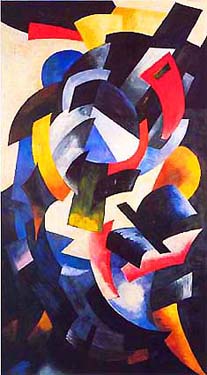
Colored Rhythms, Alexandra Exter, 1917
Alexander Dovzhenko foregrounded history’s competing versions, constructed nature and relationship with power throughout the silent trilogy. This began in Zvenyhora with the Roksana story, continued in Arsenal with versions of civil war and revolution and concluded with Earth’s depictions of collectivization and ‘dekulakization’. After the trilogy, Dovzhenko’s aesthetic abruptly shifted to socialist realism. This transition began with Ivan (1932) and continued to a nadir with Michurin (1949). During the famine of 1933, Dovzhenko was dismissed from the disbanded VUFKU (renamed Ukrainfilm), and assigned to Mosfilm. The earlier constellative euphoric dialogue with European modernism was over.
In an edited version in 1939, Dovzhenko’s reworked Schors was released to display the regime’s alignment with ‘Ukraine’. During the war, Dovzhenko wrote propaganda, ‘supervised’ war documentaries (Liberation (1940), Battle for the Soviet Ukraine (1943), Victory in Right Bank Ukraine and Expulsion of the German Aggressors from Soviet Ukrainian Territory (1945)) and began his literary masterpiece, The Enchanted Desna. Only allowed publication after Stalin’s death, this work would inaugurate Ukrainian literature’s thaw.
Dovzhenko attempted to begin Poem of an Inland Sea (1956) after Stalin’s death. For all intensive purposes, he was a broken man.
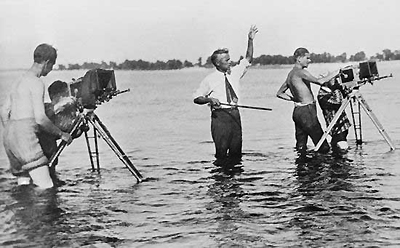
Dovzhenko beginning tests for Poem for an Inland Sea (1956) shortly before his death
Dovzhenko died in Moscow the night before principal photography was to begin. His wife, Julia Solntseva, completed the film and subsequent Solntseva-directed, Dovzhenko-named projects (The Enchanted Desna (1964), The Unforgettable, Ukraine in Flames (1961), The Golden Gate (1970).
| Jay Leyda described Zvenyhora as ‘having little to do with Dovzhenko’s basic film ideas’. This examination came to different conclusions. Zvenyhora was emblematic of an early film grouping. In terms of official ‘Soviet’ party ideology, this grouping would become muted. In Zvenyhora, Dovzhenko began to develop a classic seven act episodic structure, set of visual invocation, dialogue with the Ukrainian cultural renaissance and European modernism submerged from later discussion. Dovzhenko’s filmmaking team were participants in a cultural renaissance but because of their political valence, they were demonized or excised from mention. | 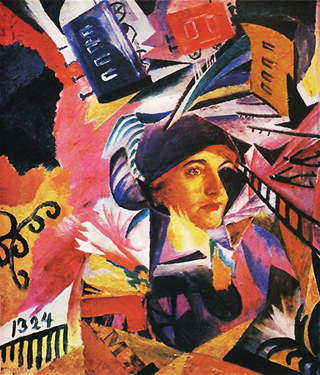 |
||
Time, David Burliuk, 1924 |
In an aesthetic concerned with Ukraine, its culture, history, ethnographic traditions and politics, Dovzhenko’s painterly background was prevalent. In dialogue with the avant garde’s Eastern European orbit, Dovzhenko placed his aesthetic into a set of modernist visual codes (Dada, surrealism, neo-Byzantine muralism). Drawing on ethnography, previously proscribed oral cultural narratives were articulated.
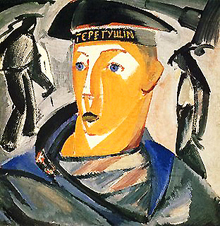 |
Arsenal (1929) was a different type of exploration far from the celebratory polemics of Eisenstein’s October (1927), Schub’s Fall of the Romanov Dynasty (1927) or Pudovkin’s End of St. Petersburg (1927). Building on an episodic experimental seven act structure, the film played out Ukraine in revolution. Instead of following party prescription, a poetic meditation was constructed, which visualized Ukraine’s brief emancipatory period. Lumping the film as a valorization of ‘the Russian Revolution’, Arsenal inaugurated the West’s placement of Dovzhenko. | ||
Sailor, Vladimir Tatlin, 1915 |
Dovzhenko reconfigured genres foregrounding a use of musicologic tropes (dumy, choric metaphor and motif, musical movement, orchestral structures) and continuing epic invocations. Dovzhenko’s aesthetic was characterized by the vertical intensification of poetry rather than the horizontal progression of drama. Through the cinematographic choices of Danylo Demutsky, the politico-modernist nature of Dovzhenko’s filmmaking team was evident. Connections were also plentiful with the proscribed Ukrainian director, Les Kurbas, playwright Mykola Kulish, Berezil Theatre’s actors and Lysenko Music and Drama School.
| The trilogy presented revolution’s triumph in death and loss, funereally veiled. In Arsenal, there was a dialogue with Eisenstein’s Potempkin. Unlike the micrologic visualization of a battleship’s mutiny to valorize revolution, Dovzhenko’s position was ambivalent. Brought to political consciousness by revolution and national emancipation, the position of the young social revolutionary intelligentsia of Dovzhenko’s generation was similarly muted. | 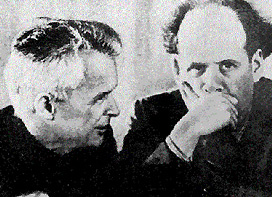 |
||
Dovzhenko and Eisenstein, late 40's |
Earth’s prints require archival restoration. Work is needed on closed and opened Dovzhenko and Soviet film archives. The historical reception by western critics is also a question deserving investigation. Earth presented a film grounded in literary sources and historic antecedents and suggested iconographic concerns, continuing an episodic structuring. Questionings of the spirit made Earth a religious investigation. Eisenstein’s Old and the New was an important contrast. The overlooked Que Viva Mexico footage was also a parallel.
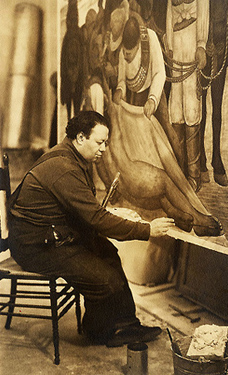 |
Dovzhenko was no less aware of international currents
or other filmic canons than other international modernists. Constructing an
iconic aesthetic, Dovzhenko was in dialogue with Mykhailo Boichuk’s neo-Byzantine
school and ‘other’ international modernist currents. In this examination, the
Mexican muralists were used to place Dovzhenko into a
different, socially conscious other modernism. To push towards opening
other connections, other bridges are needed. There is further work to be
accomplished on the former Soviet republics histories, which are little
understood or understood in terms of paradigms that are hardly adequate[357]. |
||
Diego Rivera working on Liberation of the People, circa 1923 |
In
his later years, early western VGIK student, Herbert Marshall, came to terms with
a few of these film histories as ‘Crippled Creative Biographies’. Zvenyhora challenged and syncretized modernism’s art with an established ethnographic tradition. Arsenal foregrounded history’s competing versions. Earth’s collectivization
and dekulakization visualized a funereal hymn. Dovzhenko attempted to extend medium and modernist horizons
but also the complexities of socio-cultural discourse through cinema’s
early synthetic aspirations.
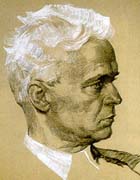
Dovzhenko, Final Self-Portrait 1956
Introduction |Zvenyhora (1928) | Arsenal (1929) | Earth (1930) | Conclusions|
Filmography | Earth Chronology | Bibliographies| Contact
Notes
[355] See Stalin, I. “Ob antileninskikh
oshibkakh i natsionalisticheskikh izvashcheniakh
v kinopovesti Dovzhenko Ukraina v ogne.” Reprinted in Iskusstvo kino
1990.4.: pp. 84-96.
[356] See Kenez, Peter. Cinema
and Soviet Society 1917-1953 Cambridge: New York, 1992. In particular Part
III: The Death of Soviet Film: Chapter 10 “Film Hunger” and Chapter 11 “The
Nadir 1945-1953”. pp. 209-247.
[357] With regard to the
non-Russian republics (i.e. Georgia, Armenia, Moldavia, Azerbaijan, et al.),
the larger cinematic histories of these republics, like Ukrainian cinema,
largely remains a blank slate for the West but work has slowly begun. For the
Georgian cinema (Abuladze, Ioselani)
see Radvanyi, Jean, Le
Cinéma Georgien. collection dirigée par Jean-Loup Passek. Paris: Centre Georges Pompidou, 1988. For a partial
post-Soviet Russian list of Stalinist censored and withdrawn republics’ cinema
see Margolit, Evgenii and Smyrov, Vyacheslav. Iz’yatoe
Kino. Moskva: Double-D, 1995. For the
Soviet Central Asian cinema and culture see Passek,
Jean-Loup. Le Cinema D’Asie Centrale Sovietique.
Paris: Centre Georges Pompidou, 1991.